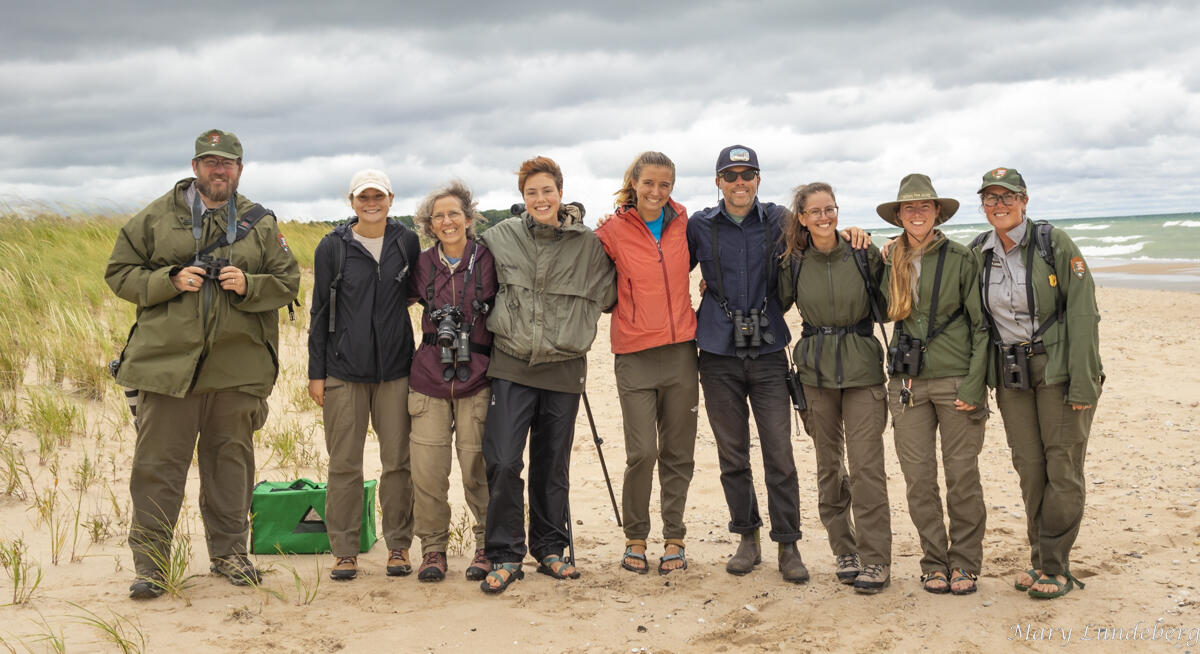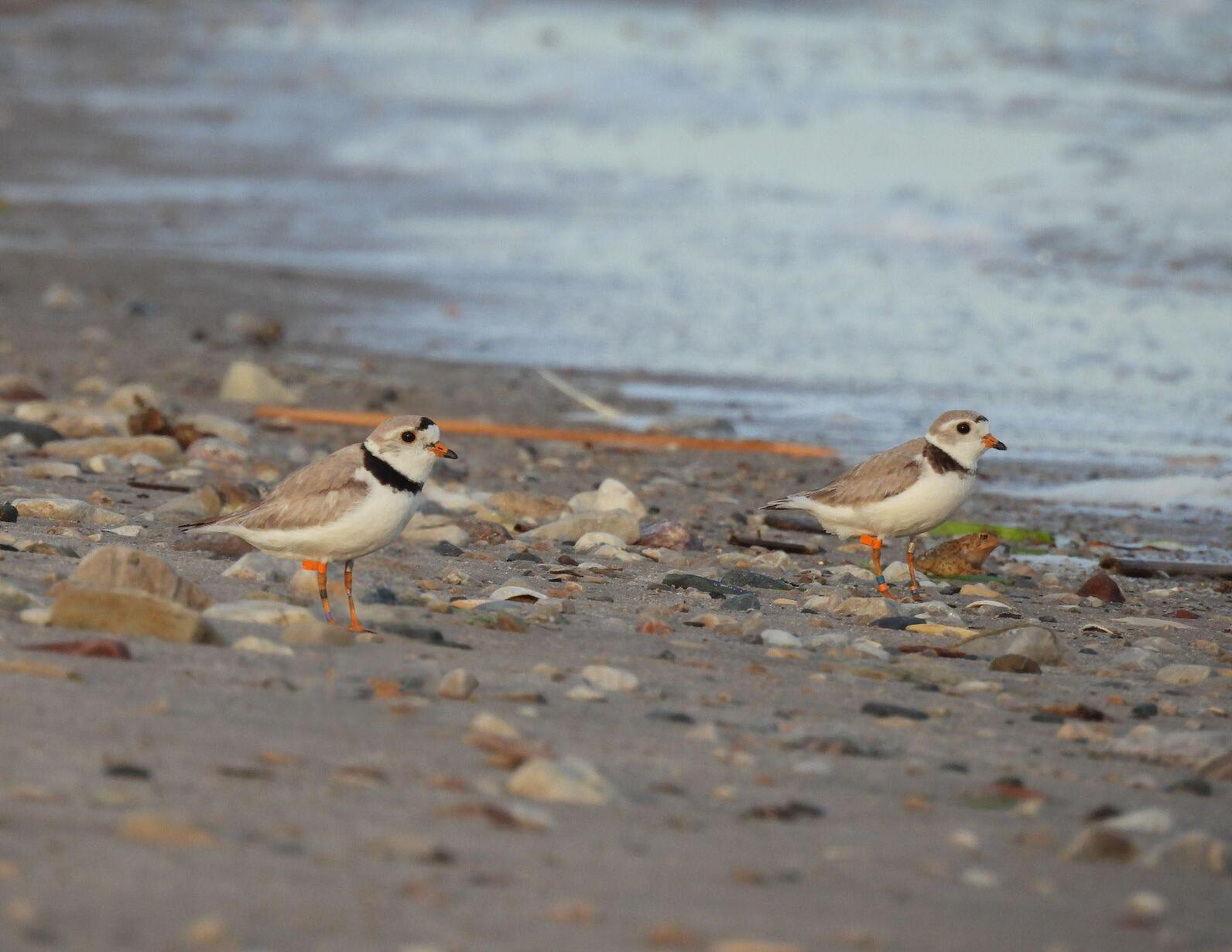(Septermber 6, 2024) This year's breeding season for Great Lakes Piping Plovers marks a significant milestone, as these remarkable shorebirds have achieved their third consecutive record-breaking breeding season. There was a total of 81 unique breeding pairs across the region this summer (the most since their Endangered Species Act listing), which is one more than last year’s record of 80 pairs. Against the backdrop of ongoing conservation challenges, the continued success of these endangered birds stands as a testament to the tireless efforts of dedicated conservationists, volunteers, and community members. As the Great Lakes Piping Plover Conservation Team celebrates this achievement, we are reminded of the powerful impact that collective action can have on safeguarding our natural world.
The goal of the Great Lakes Piping Plover recovery effort is to restore and maintain a viable plover breeding population across the Great Lakes coastline, and eventual removal of the population from the Endangered Species list. This goal is considered accomplished when the population reaches at least 150 nesting pairs for at least five consecutive years. As the second consecutive year with at least 80 pairs, the population is headed in the right direction after being relatively stagnant around 70 – 75 pairs over the last few years. In the 2022 breeding season, a record-breaking 150 chicks fledged in the wild (from 72 pairs), which has undoubtedly contributed to the boost in population size during 2023 – 2024. However, maintaining this momentum is no easy task.

Challenges Facing Piping Plovers
Piping Plovers face a variety of threats that put their survival at risk. Habitat loss due to shoreline development and human disturbance are primary concerns, as these birds rely on relatively undisturbed sandy beaches for nesting. Predation by animals such as coyotes, merlins, and even dogs poses a significant threat to eggs and chicks. Climate change only adds to these challenges by increasing the frequency and intensity of storms, which can wash away nests and erode critical nesting sites. Additionally, extreme temperatures make it difficult for young chicks to regulate their body temperatures.
To combat these threats, volunteers and monitors at nesting sites spend their day on beaches, educating beachgoers, observing Plovers’ behaviors, and protecting them from dogs, predators, and other disturbances. This is just one piece of the broader conservation efforts coordinated by the Conservation Team, which includes partners from organizations like the University of Minnesota, U.S. Fish and Wildlife Service, National Park Service, US Forest Service, state Departments of Natural Resources, Birds Canada, Great Lakes Tribes, Detroit Zoo, Audubon, Lake Superior State University and many others. Conservation strategies include protecting nests with exclosures, monitoring sites, education and outreach, captive-rearing, and annual banding. These collaborative efforts have helped the Great Lakes Piping Plovers grow from fewer than 15 pairs in the 1980s to over 80 pairs in the last two summers.
Captive-Rearing and Recovery Success
From 81 pairs this summer, 124 chicks fledged in the wild—a fledging rate of 1.5 chicks per pair, meeting the annual recovery goal. In addition to chicks raised in the wild, recovery efforts for Great Lakes Piping Plovers include captive rearing. When a nesting adult goes missing or if a storm washes out a nest, the eggs are recovered and brought into captive-rearing so that they have a chance of hatching.
The captive-rearing program, housed at the University of Michigan Biological Station in Pellston, MI, raised and released 17 chicks into the wild this summer. These efforts bring the total fledglings for this season to 141, with a fledging rate of 1.7 chicks per pair, well above the recovery goal. Captive-reared birds are playing an increasingly important role, with 20 observed throughout the Great Lakes region this year, 14 of which nested.
Each captive-reared bird represents the culmination of many hands—from site monitors rescuing eggs to zookeepers raising the birds. For those curious to learn more about the journey of a captive-reared Piping Plover, check out the newly published book Raised to be Wild: The Tale of Great Lakes Piping Plover, featuring photos and stories of these birds and the Conservation Team members working to protect them.
Video: Great Lakes Piping Plover chicks released in the Upper Pennisula in Michigan by Sarah Foote, zookeeper at Detroit Zoo.
New Beginnings and Re-established Nesting Sites
Audubon Great Lakes coordinates staff, partners, and volunteers to monitor Piping Plovers at the Cat Island Restoration Site and Long Point in Green Bay, WI. This season, the Cat Island Restoration Chain and nearby Longtail Point saw a total of 10 fledglings produced from four nests. Six chicks fledged successfully in the wild while four chicks were reared in captivity and released. A new pair of Plovers nested at Longtail Point for the second year in a row, and second time in recorded history - a significant development for the region's efforts to recover this species.
Another exciting update from the season includes four re-established nesting locations where plovers have been absent for several years but have returned to breed once again. Perhaps the most anticipated nesting revival was at Montrose Beach in Chicago, IL, where the beloved Monty and Rose used to rule the roost. After Monty died of a fungal respiratory infection shortly after returning to Montrose in 2022 (before he could nest), no plovers have successfully nested at the site since 2021 – though one of Monty’s 2021 offspring, Imani, certainly tried. Although unsuccessful in securing a mate in 2022 and 2023 while there, Imani’s third time was the charm. This year, he paired up with Searocket, a captive-reared chick that was released at Montrose last year in the hopes that she would return to nest there this summer. And the gamble paid off! Imani and Searocket’s chicks hatched in July and one chick successfully fledged. Thanks to dedicated Conservation Team members and volunteers with the Chicago Piping Plovers, these birds were well-monitored and protected despite the hustle and bustle of an urban beach.
Other re-established nesting sites this year include Waukegan, IL (where three chicks fledged from 1 brood); Port Inland, MI (where seven chicks fledged from two broods); and Bad River, WI (where three chicks fledged from 1 brood).

Tracking the Journey Through Banding
If you are curious how these birds can be individually identified, it is through annual banding efforts. The banding crew, led by Dr. Francie Cuthbert and Stephanie Schubel of the University of Minnesota, band every adult and chick in the population each summer so that we can learn about the survival, reproductive success, longevity, and migration patterns of this population. Banded Piping Plovers that are from the Great Lakes are easy to identify because orange is the unique color band identifier for this population. This year, the banding crew banded 162 wild chicks and 32 adults across the region – that’s a notable accomplishment, given that birds are nesting as far west as Minnesota and as far east as New York and Pennsylvania.
“Banding is a powerful tool for allowing people to connect with their local plovers and follow plover stories across the Great Lakes,” said Stephanie Schubel, head bander and field crew lead. “For me, it connects me with the people on the ground, who are monitoring and protecting at these sites, contributing to this critical recovery work every day.”
Banding also helps track where Great Lakes plovers are spending their winters, as volunteers and birders report their observations to the University of Minnesota wintering database manager Alice Van Zoeren. The population overwinters primarily along the Atlantic coast in Georgia and the Carolinas, but a few Great Lakes birds have been reported wintering as far south as Cuba and the Bahamas. Individuals are already being seen at some wintering locations, including newly fledged birds who are making their first trip south.
The first 2024 fledgling to be reported at a wintering site was found at Harbor Island, SC; the bird had hatched at Fisherman’s Island State Park, MI and was last seen in that area about three weeks earlier. That’s a fairly fast trip for a bird navigating its first migration without parental guidance. Indeed, soon after that report, the fledgling’s father was seen in Bolivar, TX – a far distance from his offspring’s preferred winter spot. Perhaps they will reunite at Fisherman’s Island State Park next year to raise families alongside each other.
Looking Ahead
Following a third consecutive record-breaking season, the Great Lakes Piping Plover population—and the devoted Conservation Team partners—are soaring to new heights. The countless hours of hard work, many helping hands, and vigilant protection efforts are paying off, bringing tangible results for these charismatic little birds that grace the Great Lakes beaches each summer. While there is still much work ahead to achieve full recovery, the team is taking a moment to celebrate this successful breeding season and looking forward with excitement to the plovers’ return to our shores next spring. You can help and remind others to share the shore using our social media toolkit.





